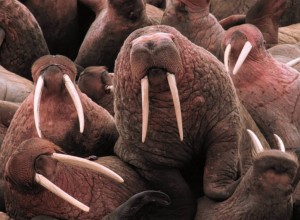 The Pacific walrus, a large marine mammal, may be endangered because of the effects of rising temperature to their natural habitat. Just like the polar bears, walruses are in agony because of the insufficiency of summer and fall sea ice in the Arctic waters. Scientists attribute this to global warming.
The Pacific walrus, a large marine mammal, may be endangered because of the effects of rising temperature to their natural habitat. Just like the polar bears, walruses are in agony because of the insufficiency of summer and fall sea ice in the Arctic waters. Scientists attribute this to global warming.
Walruses thrive on floating ice. They normally rest, find their food and nurture their little ones in cold Arctic sea ice. Because of the intense climate change, Pacific walruses have been forced to live on land.
According to the U.S Geological Survey, thousands of walruses have gathered on one rocky island.
This relocation is harmful to the marine mammals because their food supplies near the island can be hastily exhausted. Not only that, walruses might get scared and panicked, causing a stampede that can kill many of their small members.
The global climate change is affecting the Arctic and Antarctic areas more quickly than the other regions of the world.
Although it is difficult to get the accurate number of their whole population, the walruses may be included under the Endangered Species Act.
Evident haul-out can also be seen in other areas of Alaska and Siberia. These walruses are now showing up on some beaches in the north-western Alaska, as well as across the Bering Strait in the north-eastern Siberia.
This year’s summer sea ice levels had reached its third-lowest point since the 1979 satellite measurements as told by the National Snow and Ice Date Center located in Boulder Colorado.

